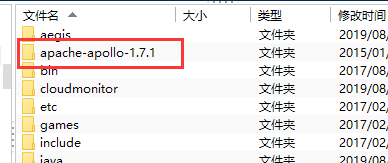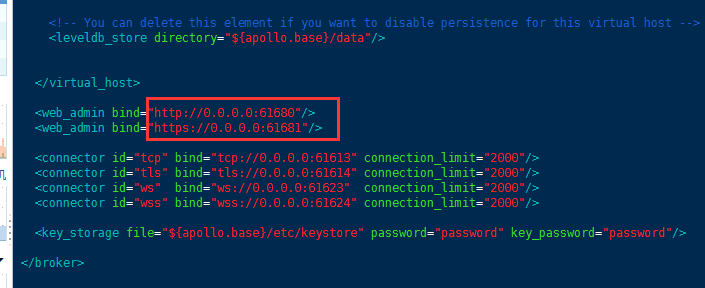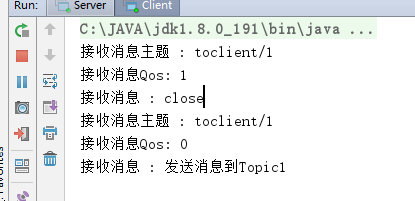基于ubuntu16的mqtt服务器(apache-apollo1.7.1)
感谢博客:https://www.cnblogs.com/chenrunlin/p/5109028.html
需要环境:
java1.8

把文件通过finalshell扔到/usr/local目录下
使用命令
# sudo tar -zxvf apache-apollo-1.7.1-unix-distro.tar.gz

然后
我配置了一下apollo_home 更改 /etc/profile

按exc键后输入:wq保存
然后
# sudo -s
# source /etc/profile
刷新配置
再进入/var/lib
# cd /var/lib/
新建Mybroker
# /usr/local/apache-apollo-1.7.1/bin/apollo create mybroker

再更改mybroker中/etc/apollo.xml
#vim /var/lib/mybroker/etc/apollo.xml

红框中改为0.0.0.0
最后运行
# nohup /var/lib/mybroker/bin/apollo-broker run
nohup是为了关闭ssh之后也能在后台运行

注意点:
1、可能有时候需要sh命令 比如说 sh apollo create mybroker
2、阿里云必须开放apollo.xml中的端口,如61680.61681等。
3、是否成功通过ip+61680即可知道。
4、初始账号密码是admin,password,存放在etc目录的users.properties下
5、注意nohup命令运行,不然可能断开连接后自动关停服务
成功截图:

附送一下测试Demo,需要的jar包是
org.eclipse.paho.client.mqttv3-1.2.0.jar

服务器端server:
import org.eclipse.paho.client.mqttv3.MqttClient; import org.eclipse.paho.client.mqttv3.MqttConnectOptions; import org.eclipse.paho.client.mqttv3.MqttDeliveryToken; import org.eclipse.paho.client.mqttv3.MqttException; import org.eclipse.paho.client.mqttv3.MqttMessage; import org.eclipse.paho.client.mqttv3.MqttPersistenceException; import org.eclipse.paho.client.mqttv3.MqttTopic; import org.eclipse.paho.client.mqttv3.persist.MemoryPersistence; /** * * Title:Server * Description: 服务器向多个客户端推送主题,即不同客户端可向服务器订阅相同主题*/ public class Server { public static final String HOST="tcp://IP地址:61613"; public static final String TOPIC1="toclient/1"; public static final String TOPIC2="toclient/2"; public static final String clientid="server"; public MqttClient client; public MqttTopic topic1; public MqttTopic topic2; public String userName = "admin"; public String passWord = "password"; public MqttMessage message; public void connect() { MqttConnectOptions options = new MqttConnectOptions(); options.setCleanSession(false); options.setUserName(userName); options.setPassword(passWord.toCharArray()); options.setConnectionTimeout(10);//设置超时时间 options.setKeepAliveInterval(20);//设置 try { client.setCallback(new PushCallback()); client.connect(options); topic1 = client.getTopic(TOPIC1); topic2 = client.getTopic(TOPIC2); }catch (Exception e) { // TODO: handle exception e.printStackTrace(); } } public void publish(MqttTopic topic,MqttMessage message) throws MqttPersistenceException, MqttException { MqttDeliveryToken token = topic.publish(message); token.waitForCompletion(); System.out.println("消息推送成功 !"+ token.isComplete()); } public Server() throws MqttException { client = new MqttClient(HOST, clientid,new MemoryPersistence()); connect(); } public static void main(String[] args) throws MqttException { Server server = new Server(); server.message= new MqttMessage(); server.message.setQos(2); /* QoS 0,最多一次送达。也就是发出去就fire掉。 QoS 1,至少一次送达。发出去之后必须等待ack,没有ack,就要找时机重发 QoS 2,准确一次送达。消息id将拥有一个简单的生命周期。 * */ server.message.setRetained(true); server.message.setPayload("发送消息到Topic1".getBytes()); server.publish(server.topic1, server.message); System.out.println(server.message.isRetained() + "----ratained状态"); } }
监听端Client:
import java.util.concurrent.ScheduledExecutorService; import org.eclipse.paho.client.mqttv3.MqttClient; import org.eclipse.paho.client.mqttv3.MqttConnectOptions; import org.eclipse.paho.client.mqttv3.MqttTopic; public class Client { public static final String HOST="tcp://IP地址:61613"; public static final String TOPIC="toclient/1"; private static final String clientid="clientid1"; private MqttClient client; private MqttConnectOptions options; private String userName = "admin"; private String passWord = "password"; private ScheduledExecutorService scheduler; private void start() { try { client = new MqttClient(HOST, clientid); options = new MqttConnectOptions(); options.setCleanSession(true); options.setUserName(userName); options.setPassword(passWord.toCharArray()); // 设置超时时间 单位为秒 options.setConnectionTimeout(10); // 设置会话心跳时间 单位为秒 服务器会每隔1.5*20秒的时间向客户端发送个消息判断客户端是否在线,但这个方法并没有重连的机制 options.setKeepAliveInterval(20); client.setCallback(new PushCallback()); MqttTopic topic = client.getTopic(TOPIC); options.setWill(topic, "close".getBytes(), 2, true); client.connect(options); int []Qos = {1}; String [] topic1 = {TOPIC}; client.subscribe(topic1,Qos); }catch (Exception e) { // TODO: handle exception e.printStackTrace(); } } public static void main(String[] args) { // TODO Auto-generated method stub Client client = new Client(); client.start(); } }
回调函数 PushCallback:
import org.eclipse.paho.client.mqttv3.IMqttDeliveryToken; import org.eclipse.paho.client.mqttv3.MqttCallback; import org.eclipse.paho.client.mqttv3.MqttMessage; /** * 发布消息的回调类 * * 必须实现MqttCallback的接口并实现对应的相关接口方法CallBack 类将实现 MqttCallBack。 * 每个客户机标识都需要一个回调实例。在此示例中,构造函数传递客户机标识以另存为实例数据。 * 在回调中,将它用来标识已经启动了该回调的哪个实例。 * 必须在回调类中实现三个方法: * * public void messageArrived(MqttTopic topic, MqttMessage message)接收已经预订的发布。 * * public void connectionLost(Throwable cause)在断开连接时调用。 * * public void deliveryComplete(MqttDeliveryToken token)) * 接收到已经发布的 QoS 1 或 QoS 2 消息的传递令牌时调用。 * 由 MqttClient.connect 激活此回调。 * */ public class PushCallback implements MqttCallback { public void connectionLost(Throwable cause) { System.out.println("连接断开,可以重连!"); } public void deliveryComplete(IMqttDeliveryToken token) { // TODO Auto-generated method stub System.out.println("deliveryComplete -- "+token.isComplete()); } public void messageArrived(String topic, MqttMessage msg) throws Exception { // TODO Auto-generated method stub System.out.println("接收消息主题 : "+topic); System.out.println("接收消息Qos: "+msg.getQos()); System.out.println("接收消息 : "+ new String(msg.getPayload())); } }
效果:
先运行client端。

再运行server端发送给订阅者:

再次查看监听端:




